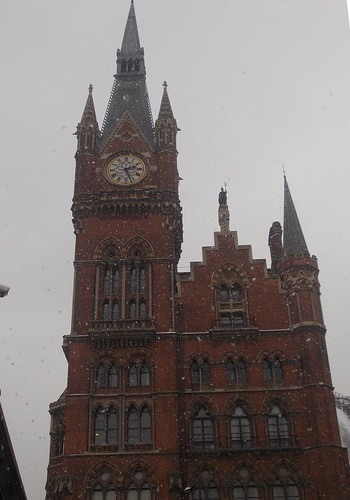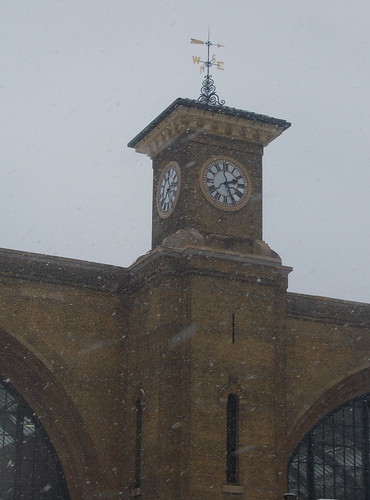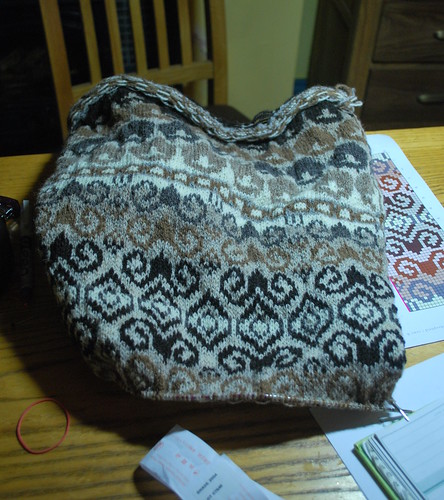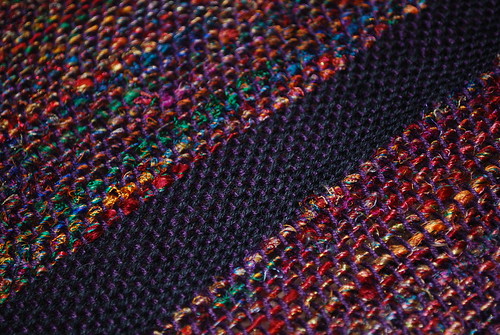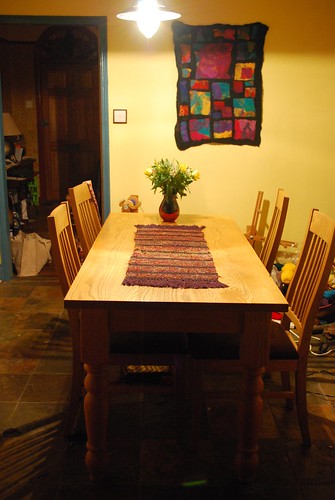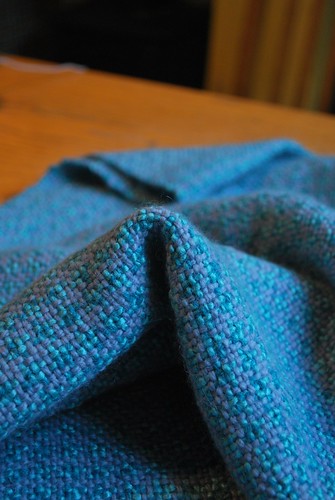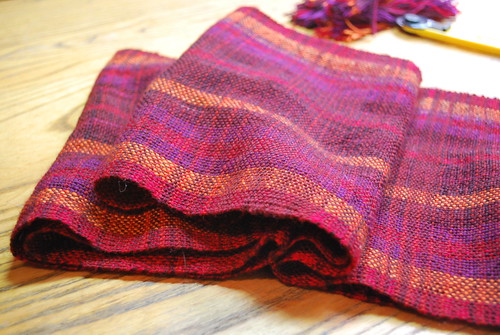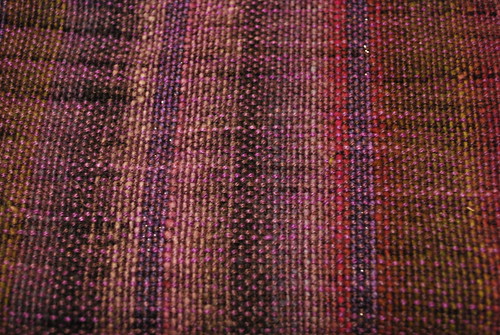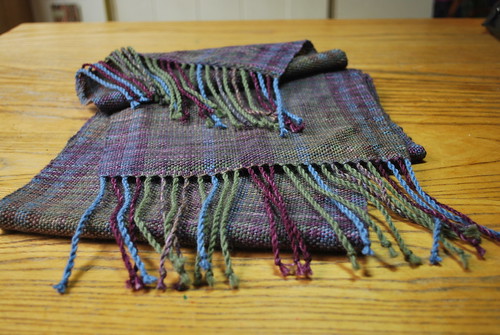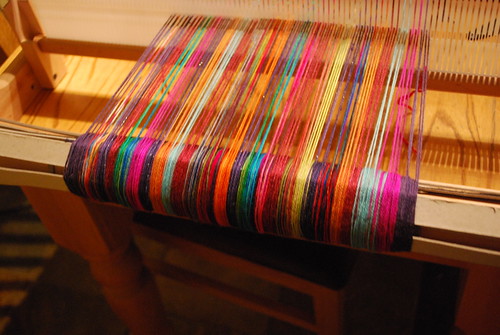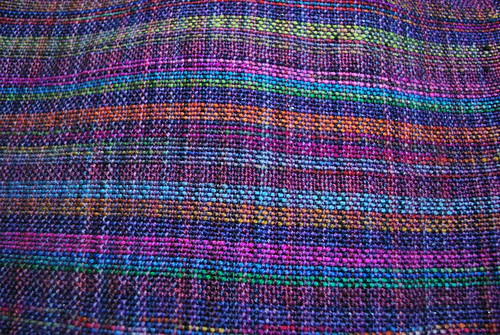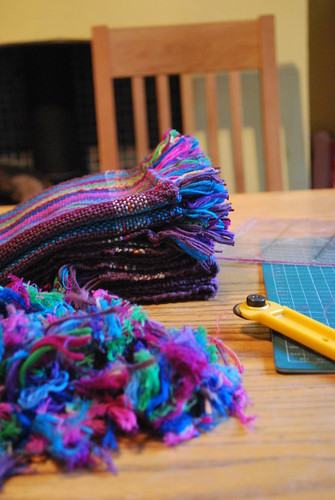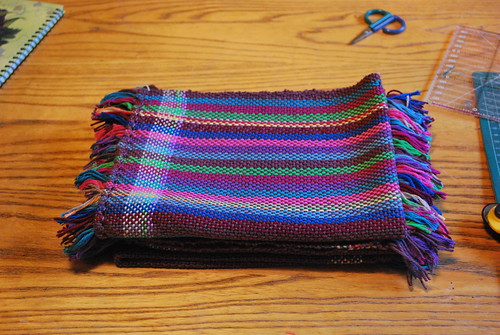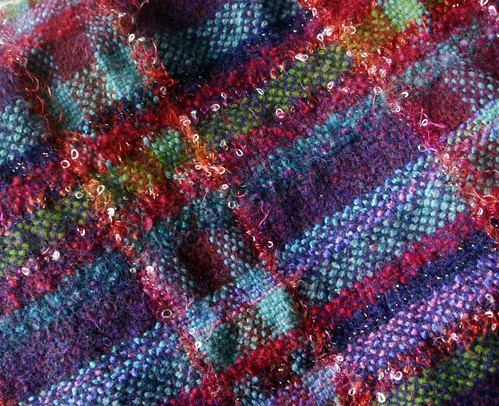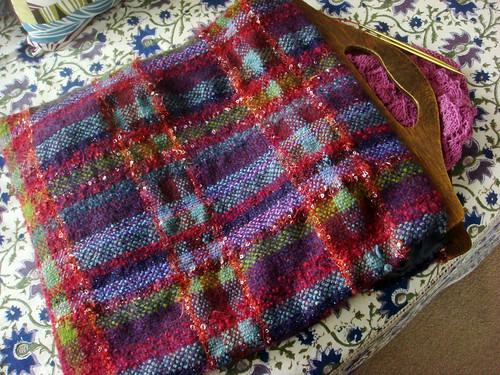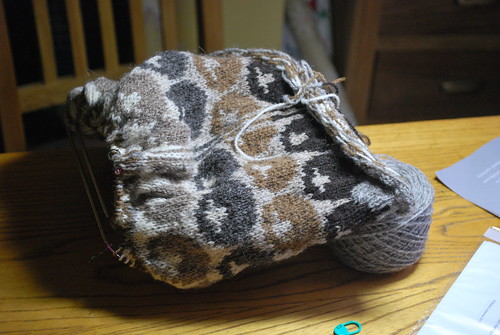The first chapter of Jane Patrick's superb
Weaver's idea book: creative cloth on a rigid heddle loom is called "There's nothing plain about plain weave". And this year has proved her right. At Christmas 2011, I thought I'd do a couple of plain projects, and then start thinking about making something more fancy... Little did I know that I'd be going into 2013 with a number of plain weave projects planned...
The inaugural project was this table runner, made with some sari silk a kind Canadian friend sent me for Christmas, combined with a bamboo warp and some grey Jaeger Matchmaker DK from stash.
It came out shorter than I was intending, because I didn't realise that a) projects shrink, particularly if the warp is stretchy bamboo and b) there's quite a lot of waste at both ends of the warp; but it's spent a lot of time on the table this year and I love it.
The second project was a birthday scarf for the same Canadian friend. I used a silk and wool blend with a sheen (green), and an angora blend (blue) in a 2 by 2 houndstooth pattern, and loved the drape of the fabric.
The learning point for this one was that a warp with angora in it is a Bad Idea from the point of view of having to de-pill it while you're working!
On February 11th last year, I spent over an hour standing on a station at -12C waiting to go to Kew Garden to meet knitting friends, before giving up (frozen points at Ely) and warping up the loom for the Not-Kew Scarf.
This was my first 4-ply project and I'd bought a 10-dent heddle for it - lots of leftovers for the warp, and a skein of Wollmeise for the weft; when I eventually got to Kew on April 21 to meet some of the same friends, I wore the scarf.
The next project was for my Dad, and was the first of a sequence for much of the rest of the year. I used a skein of Sanguine Gryphon Eidos, which I'd been warned wasn't robust enough for socks, as the weft, and a skein of Kaffe Fassett Design Line, along with some other bits and bobs, for the warp.
Over the winter, I'd started looking at chaps' scarves, in particular those ones with the fine vertical lines on them, and realised that they had sort of twisted fringes which looked more masculine than the loose fringes, and didn't involve trying to work out how to make a hem. So I tried that with the help of an online tutorial. Turned out nicely; and the scarf (and Dad) went to operas in Berlin.
This idea of using a yarn with a long variegation for the warp took me through two projects: this one which used a skein of Noro Kureyon sock for the warp with the odd smidge of a Fyberspates yarn with stellina in it, and one of Knitwitches silk and baby camel in purples and black for the weft.
The Kureyon, being a single ply, also had the advantage of doing its own twirling for the fringes...
The logical step then was to wonder what would happen with Kureyon used for warp and weft; this one was for Jackie. Strangely, this is one I don't have a picture of finished... but you can get the idea. The long colour changes in the weft and the shorter ones in the warp make an interesting interplay.
A skein of Yarnscape "Dance" combined with some leftover sock yarn and some Jaeger extra fine merino 4 play made a scarf for Rosie's birthday - this was made in August but not handed over until November...
Another project during the Olympics was a laceweight cashmere and wool scarf for my Mam - Knitwitches pure cashmere for the weft, and KnitPicks Shadow laceweight for the warp and some weft stripes. I bought a 12.5-dent heddle for that one, so am all set for everything but chunky weight!
Back to a colourful weft for a birthday present for
Wibbo; this was nice to do during one of my weeks' holiday - I seemed to pick the worst weeks of what was quite a reasonable couple of months otherwise!
The weft on this one was a skein of Malabrigo sock - I love the way the warp just peeks out.
I went for a similar effect for tablemats for my cousins for Christmas - brightly coloured cottons with a pinkish-brown main colour.
For these, I did Italian hemstitching, which just about finished off my wrists...
Last project of the year was a slightly insane tartan, using a combination of non-feltable DK weight yarns combined with the odd strand of novelty bouclé; this was great fun to do.
I was aiming for something which looked like a plaid made for Helena Bonham Carter by Vivienne Westwood and was pleased with the result.
It went wonderfully with some handles salvaged from an old knitting bag which once belonged to Grandma.
Thanks to Jan Eaton for the last two photos! Most of the weaving went on the bag, but there's a square left over which is big enough for a small cushion for me; will make that up when I find a cushion pad.
The next project is big, and also plain weave. I've just noticed that I've only kept two of the projects so far, so this is going to be a blanket, in three pieces, for my bed. I'm going to use the "mad plaid" idea, this time with superwash yarn; not attempt to match up the weave but try and keep the colour balance reasonably consistent. If I can get some sort of balance it might be a bit like Kaffe Fassett's
Crosspatch design... maybe... although I'd never pretend to have his sort of colour sense.
What I've enjoyed about the weaving is that there's some planning involved, but no so much that you get intimidated, and it's all about playing with colours. Once you actually start weaving the weft, there are a limited number of choices to be made and it has a nice mechanical action like plain stocking stitch. Immensely satisfying.
(And you use up a lot of stash doing it - never a bad thing!)
There are another four chapters of more complicated ideas in the book - I think it'll last me some time. The absolutely wonderful
Rigid Heddle group on Ravelry has been excellent for support, help and answers to questions I wouldn't even have thought to ask, too...



